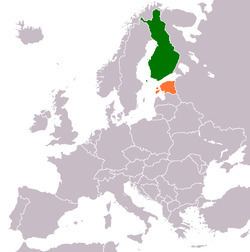 | ||
Finland-Estonia relations are foreign relations between Finland and Estonia. Both countries restored diplomatic relations on August 29, 1991. Finland has an embassy in Tallinn and an honorary consulate in Tartu. Estonia has an embassy in Helsinki and five honorary consulates, located in Oulu, Turku, Ekenäs, Tampere and Kotka. Both countries are full members of the Council of the Baltic Sea States, European Union and the Eurozone.
Contents
Finland's main language, Finnish, is related to Estonian, and there is and has been a certain feeling of kinship. 76% of Finns have visited Estonia, and in 2004, 1.8 million Finns reported visiting Estonia. The excise tax on alcohol is lower in Estonia than in Finland, thus it is common to buy large volumes of alcohol when returning from Estonia: a study in 2014 indicated that 34% of alcohol sold in Estonia is bought by Finns. Finnish and Swedish investors are the largest foreign investors in Estonia. Both Finland and Estonia are members of the European Union, Schengen agreement and the Eurozone, freeing international travel and trade between the countries. Finland is Estonia's top import partner, accounting for over 15% total import value in 2012, as well as the second-greatest market for Estonia's exports after Sweden. Finland's government recognised Estonia's independence in 1920. In response to the Soviet invasion, diplomatic missions were de facto removed. However, when Estonia restored her independence, this "temporary obstruction" was resolved. Finland contributed and continues to contribute military aid to Estonia, such as officers' training, and the provision of equipment.
Unification proposals
In Finland, the idea of a unified Greater Finland gained popularity and influence rapidly in 1917, but lost support after World War II and the Continuation War.
In Estonia of 1917, 1918 and 1940, the president Konstantin Päts wished for a union of finnic countries in his political testament, writing an outline of a unification plan. He used the term "soomesugu" in estonian to point to the people and countries of Finland and Estonia when talking about common border law.
Anthem
The melody of the Finnish anthem Maamme is also used for the national anthem of Estonia.
With a similarly themed text, Mu isamaa, mu õnn ja rõõm, My Fatherland, My Happiness and Joy (1869).[5] It is also considered to be the national anthem for Livonians with text Min izāmō, min sindimō, My Fatherland, my native land.
Regional cooperation
Finnish and Swedish investors are the largest foreign investors in Estonia. Both Finland and Estonia are members of the European Union, Schengen agreement and the Eurozone. Finland is Estonia's top import partner, accounting for over 15% total import value in 2012, as well as the second-greatest market for Estonia's exports after Sweden.
Finland's government recognised Estonia's independence in 1920. Finland contributed and continues to contribute military aid to Estonia, such as officers' training, and the provision of equipment.
